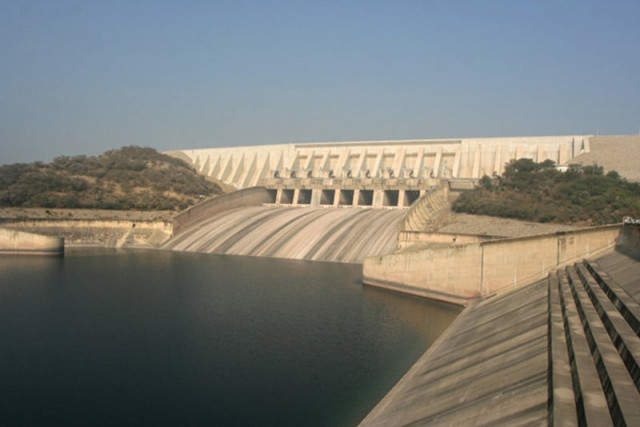Mangla outflow dips to only 100 cusecs
Currently just 2.061 MAF of water available in dam

The outflow of water from Mangla Dam -- the country's second-largest reservoir -- has dwindled to a mere 100 cusecs because of a sustained decline in the water level, primarily attributed to heavy snowfall in the upper reaches of the Himalayan state of Jammu and Kashmir on late Friday.
The dam has been consistently drying up, with inflows diminishing owing to the intermittent snowfall in the Himalayan belt and an unprecedented decrease in water flow in the rivers feeding into the reservoir.
The water level in the Mangla Dam, situated in Mirpur district of Azad Jammu and Kashmir (AJK), has experienced an alarming reduction, reaching 1,156.80 feet on Wednesday.
The current levels are below the maximum conservation level of 1,242 feet, indicating a live storage capacity of 2.061 million acre feet (MAF) in the reservoir, according to official sources on Friday.
The sources further said the water level in the dam was continuing to gradually decrease.
Due to the consistent influx of water throughout the current season, the water level in Mangla Dam reached 1,156.80 feet by Friday, following the discharge of 85.20 feet from the reservoir, the sources added.
Mangla Dam achieved its maximum conservation capacity of 1,242 feet on August 17 as part of the seasonal impounding of the reservoir.
Read: ‘Sindh to give 2,000 cusecs of water to Balochistan’
As of Friday, the media wing of the Water and Power Development Authority (Wapda) reported that there was currently 2.061 MAF available in Mangla Dam.
Both the inflows and outflows of the Jhelum River at the Mangla reservoir were documented at 5,400 cusecs. Only 100 cusecs of water was discharged from the dam on Friday.
The live storage in Tarbela Dam on Saturday was recorded at 2.275 MAF with the present water level of 1480.37 feet.
The live storage in Chashma Dam on Saturday was measured at 0.026 MAF with the present water level standing at 640.10 feet.
On Friday, the inflows into Indus River at Tarbela were recorded at 15,000 cusecs with the same amount of outflows.
Similarly, the inflows into Kabul River at Nowshera were reported at 7,900 cusecs with the outflows documented at the same amount.
The inflows at Khairabad Bridge were registered at 14,400 cusecs and outflows at the same amount.
The inflows into Jhelum River at Mangla were noted at 5,400 cusecs with outflows at 100 cusecs.
The inflows into Chenab River at Marala were measured at 4,000 cusecs with a similar amount of outflows.
The inflows at Jinnah Barrage tallied at 28,000 cusecs and outflows at 26,900 cusecs.
The inflows at Chashma Barrage were recorded at 25,400 cusecs and outflows at 18,000 cusecs.
The inflows at Taunsa Barrage were reported at 12,200 cusecs with a similar rate of outflows.
The inflows at Guddu Barrage were measured at 15,200 cusecs, with outflows at 2,800 cusecs.
The inflows and outflows at Sukkur Barrage were both noted at 4,400 cusecs.
The inflows at Kotri Barrage were reported at 4,800 cusecs, with no outflows recorded.
The inflows and outflows at Trimmu Barrage were both recorded at 5,900 cusecs.
Similarly, the inflows and outflows at Panjnad Barrage were both measured at 2,800 cusecs. APP



















COMMENTS
Comments are moderated and generally will be posted if they are on-topic and not abusive.
For more information, please see our Comments FAQ